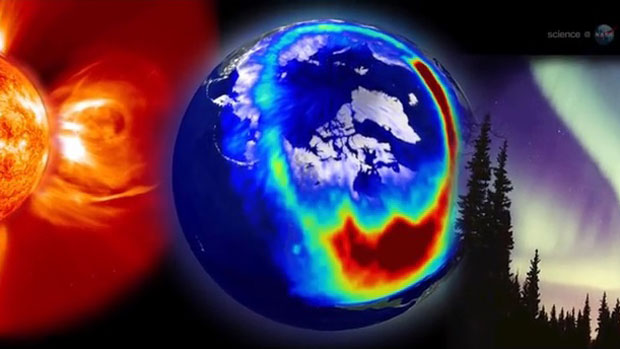Solar super storm: near miss threatened life as we know it
Space storm that narrowly missed Earth would have had a 'catastrophic effect' costing $2 trillion

Earth narrowly avoided being hit by a solar super storm that would have plunged the planet into technological chaos, according to scientists at Nasa. The most powerful solar storm in more than 150 years tore through the space between the Sun and Earth's orbit on 23 July 2012. Luckily it missed, but physicists say there could be another one coming...
What is a solar super storm?
The largest explosions in the solar system are known as coronal mass ejections (CME). It is essentially an eruption of billions of tons of superheated gas called plasma that emerges from the sun like a cloud and blasts into space travelling at more than four million miles an hour. Some become even larger than the Sun itself.
The Week
Escape your echo chamber. Get the facts behind the news, plus analysis from multiple perspectives.

Sign up for The Week's Free Newsletters
From our morning news briefing to a weekly Good News Newsletter, get the best of The Week delivered directly to your inbox.
From our morning news briefing to a weekly Good News Newsletter, get the best of The Week delivered directly to your inbox.
What damage would it do?
Analysts believe a direct hit by an extreme CME, such as the one that missed Earth in July 2012, could cause widespread power blackouts, disabling everything that plugs into a wall socket. "An extreme solar storm could knock out the power grid for weeks or even months, destroying the technology that powers our civilisation, from communications to banking to our water supply," says the Discovery Channel. The consequences could be "devastating for commerce, transportation, agriculture and food stocks, fuel and water supplies, human health and medical facilities, national security, and daily life in general", says the Washington Post.
Has a super solar storm ever hit Earth?
The most significant known solar storm was the "Carrington Event" of September 1859, named after an English astronomer, Richard Carrington, who saw the flare with his own eyes. Back then, the Northern Lights stretched to Cuba, while intense geomagnetic storms destroyed telegraph wires in America and Europe giving operators electric shocks and knocking out the telegraph network as far away as Australia and Asia for two days. Scientists at Nasa say that, in a world now dependent on electricity, a similar storm today could have a "catastrophic effect", with the economic impact exceeding $2 trillion. "In my view the July 2012 storm was in all respects at least as strong as the 1959 Carrington event," says Daniel Baker, of the University of Colorado. "The only difference is, it missed."
A free daily email with the biggest news stories of the day – and the best features from TheWeek.com
Why did the July 2012 storm miss?
Luckily, when the CME tore through Earth's orbit, our planet was not in the line of fire. Baker says if the eruption had occurred just one week earlier Earth would likely have been hit. "I have come away from our recent studies more convinced than ever that Earth and its inhabitants were incredibly fortunate that the 2012 eruption happened when it did," he says. "If it had hit, we would still be picking up the pieces." Instead, the storm cloud hit the Stereo-A spacecraft, enabling scientists to analyse the data.
Will a solar storm hit Earth in the future?
In February 2014, physicist Pete Riley, from Predictive Science Inc, analysed historical records of solar storms and worked out the probability of another extreme storm hitting Earth. He believes there is a 12 per cent chance that a Carrington-class storm could hit the planet in the next ten years.
-
 ‘Jumping genes': How polar bears are rewiring their DNA to survive the warming Arctic
‘Jumping genes': How polar bears are rewiring their DNA to survive the warming ArcticUnder the radar The species is adapting to warmer temperatures
-
 January’s books feature a revisioned classic, a homeschooler's memoir and a provocative thriller dramedy
January’s books feature a revisioned classic, a homeschooler's memoir and a provocative thriller dramedyThe Week Recommends This month’s new releases include ‘Call Me Ishmaelle’ by Xiaolu Guo, ‘Homeschooled: A Memoir’ by Stefan Merrill Block, ‘Anatomy of an Alibi’ by Ashley Elston and ‘Half His Age’ by Jennette McCurdy
-
 Venezuela’s Trump-shaped power vacuum
Venezuela’s Trump-shaped power vacuumIN THE SPOTLIGHT The American abduction of Venezuelan President Nicolás Maduro has thrust South America’s biggest oil-producing state into uncharted geopolitical waters
-
 What will happen in 2026? Predictions and events
What will happen in 2026? Predictions and eventsIn Depth The new year could bring peace in Ukraine or war in Venezuela, as Donald Trump prepares to host a highly politicised World Cup and Nasa returns to the Moon
-
 How Bulgaria’s government fell amid mass protests
How Bulgaria’s government fell amid mass protestsThe Explainer The country’s prime minister resigned as part of the fallout
-
 Femicide: Italy’s newest crime
Femicide: Italy’s newest crimeThe Explainer Landmark law to criminalise murder of a woman as an ‘act of hatred’ or ‘subjugation’ but critics say Italy is still deeply patriarchal
-
 Brazil’s Bolsonaro behind bars after appeals run out
Brazil’s Bolsonaro behind bars after appeals run outSpeed Read He will serve 27 years in prison
-
 Americans traveling abroad face renewed criticism in the Trump era
Americans traveling abroad face renewed criticism in the Trump eraThe Explainer Some of Trump’s behavior has Americans being questioned
-
 Nigeria confused by Trump invasion threat
Nigeria confused by Trump invasion threatSpeed Read Trump has claimed the country is persecuting Christians
-
 Sanae Takaichi: Japan’s Iron Lady set to be the country’s first woman prime minister
Sanae Takaichi: Japan’s Iron Lady set to be the country’s first woman prime ministerIn the Spotlight Takaichi is a member of Japan’s conservative, nationalist Liberal Democratic Party
-
 Russia is ‘helping China’ prepare for an invasion of Taiwan
Russia is ‘helping China’ prepare for an invasion of TaiwanIn the Spotlight Russia is reportedly allowing China access to military training